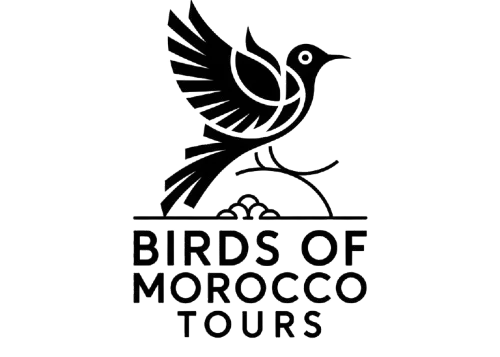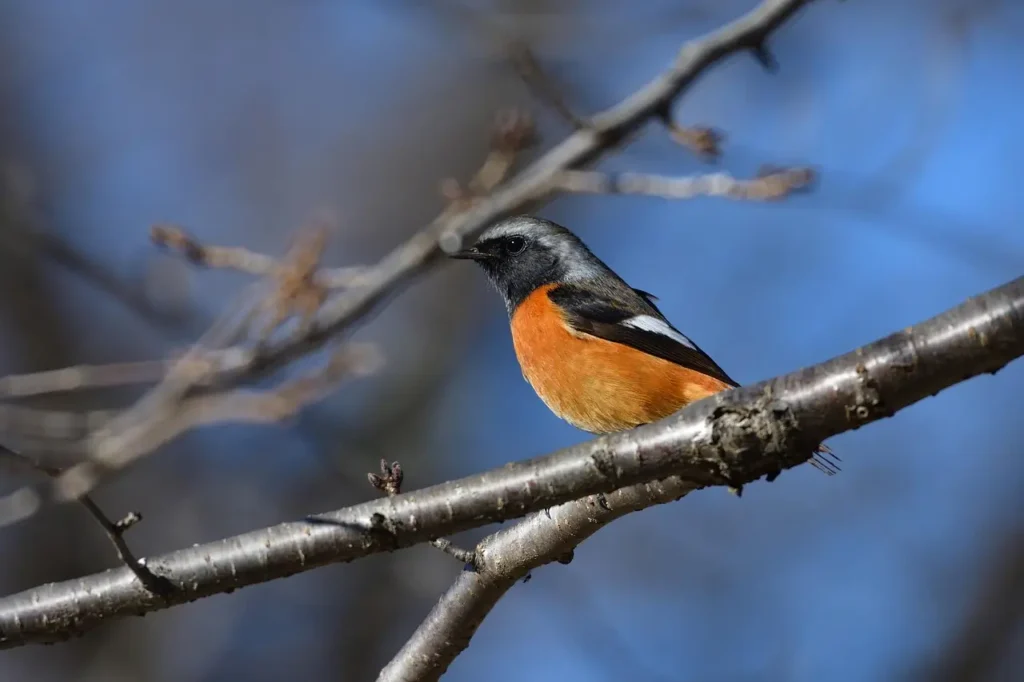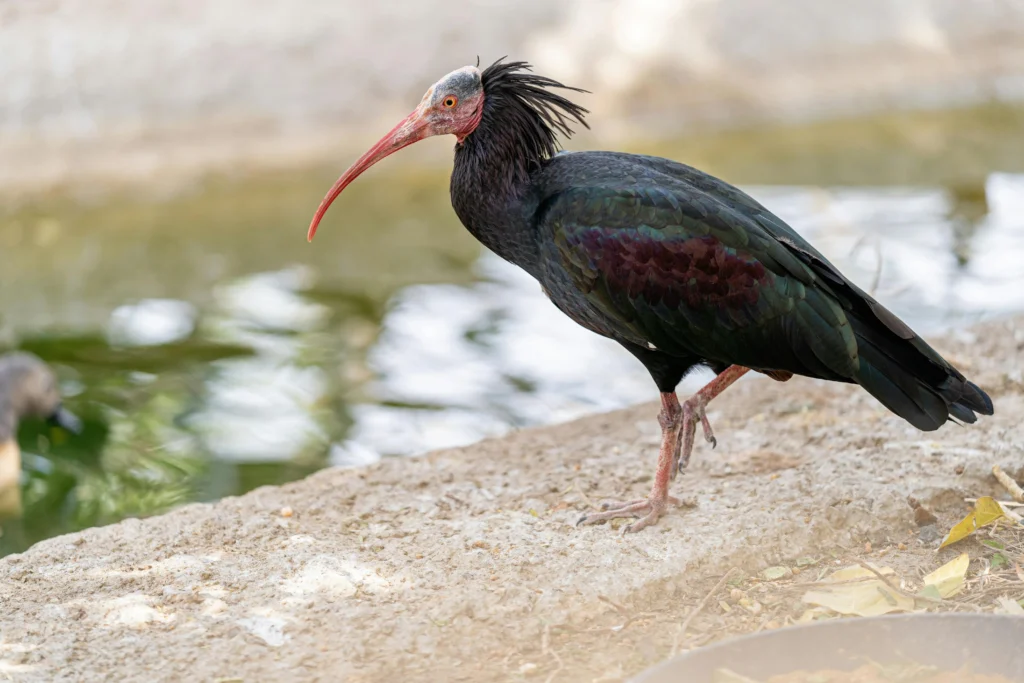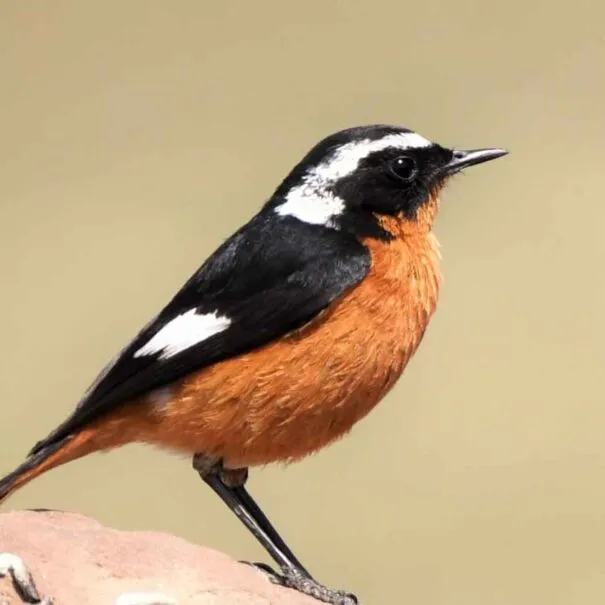Morocco is home to a diverse range of bird species, but one stands out as a true national treasure the Moussier’s Redstart (Phoenicurus moussieri). Recognized as the national bird of Morocco, this strikingly beautiful species is endemic to North Africa, meaning it can only be found in this part of the world. With its vibrant plumage and lively presence, the Moussier’s Redstart is a favorite among birdwatchers in Morocco and a symbol of the country’s rich biodiversity.
In this article, we will explore the history and symbolism behind Morocco’s national bird, its natural habitat and distribution, and the conservation efforts being made to protect this remarkable species. Whether you are a passionate birdwatcher or simply curious about Moroccan wildlife, this guide will provide everything you need to know about the Moussier’s Redstart.
The History and Symbolism of Morocco’s National Bird
The Moussier’s Redstart (Phoenicurus moussieri) holds a special place in Moroccan wildlife and is officially recognized as the national bird of Morocco. This small yet striking bird is endemic to North Africa, meaning it is found nowhere else in the world. Its bright orange-red underparts, contrasting with its black-and-white head pattern, make it one of the most visually distinctive birds in Morocco.
Why Was Moussier’s Redstart Chosen as the National Bird of Morocco?
While there are many bird species in Morocco, the Moussier’s Redstart was chosen as the national bird due to its unique characteristics and strong association with Moroccan landscapes. This bird thrives in Morocco’s mountainous regions, dry woodlands, and semi-arid environments, making it a perfect representation of the country’s diverse ecosystems.
Its name, “Moussier’s Redstart,” is derived from Jean Moussier, a French naturalist who studied North African wildlife in the 19th century. Although the bird was scientifically named after him, it has been known to Moroccan communities for centuries, often appearing in traditional folklore and local stories.
Symbolism of the Moussier’s Redstart in Moroccan Culture
As the national bird of Morocco, the Moussier’s Redstart symbolizes resilience, adaptability, and the vibrant natural beauty of the country. Unlike large predatory birds that symbolize power, this small yet agile bird represents the delicate balance of Morocco’s ecosystem.
Additionally, birds in general have long been revered in Moroccan culture. In traditional Berber and Arabic folklore, birds are often seen as messengers of good fortune, symbols of freedom, and signs of a healthy environment. The Moussier’s Redstart, with its energetic and alert nature, embodies the spirit of survival and harmony with nature.
Comparison with Other National Symbols of Morocco
Morocco has several national symbols that reflect its heritage, wildlife, and identity. Alongside the Moussier’s Redstart, the Barbary Lion—which once roamed the Atlas Mountains—is considered a national symbol of strength. The Atlas Cedar, a majestic tree found in the Moroccan mountains, also represents the country’s natural wealth.
By choosing the Moussier’s Redstart as the national bird, Morocco highlights its commitment to preserving biodiversity and its recognition of the importance of small, native species in the country’s ecosystem.
Habitat and Distribution of Moussier’s Redstart
The Moussier’s Redstart (Phoenicurus moussieri), the national bird of Morocco, thrives in the diverse landscapes of North Africa, with Morocco serving as its primary habitat. As an endemic species, it is found nowhere else in the world, making it a unique and special part of Morocco’s birdlife. This section explores the bird’s natural habitat, distribution, and the best locations for birdwatchers to spot this magnificent species in the wild.
Natural Habitat: Where Does the Moussier’s Redstart Live?
The Moussier’s Redstart is highly adaptable but prefers semi-arid and montane environments. Unlike many other redstarts that favor dense forests, this species thrives in open landscapes with scattered vegetation. Some of its primary habitats include:
- The Atlas Mountains: Found at various elevations, particularly in the Middle and High Atlas, where it inhabits rocky slopes, scrublands, and open woodlands.
- The Rif Mountains: Present in select areas, though less common than in the Atlas range.
- Souss-Massa National Park: Located along Morocco’s southwestern coast, this park provides an important refuge for many North African birds, including the Moussier’s Redstart.
- Semi-arid regions and dry woodlands: This bird can also be spotted in dry, bushy landscapes, including near valleys, riverbanks, and plateaus.
Unlike forest-dwelling species, the Moussier’s Redstart prefers areas with scattered bushes, small trees, and rocky outcrops, where it can perch and forage for insects. Its ability to thrive in these dry, rugged environments makes it an excellent representative of Morocco’s diverse ecosystems.
Geographical Distribution: Where Can You Find the Moussier’s Redstart?
The Moussier’s Redstart is a resident bird of Morocco, meaning it does not migrate long distances. However, it is also found in parts of Algeria and Tunisia, though in much smaller numbers. Its distribution is largely concentrated in:
- Morocco: The species is widespread throughout the Atlas Mountains, Rif Mountains, and coastal regions. It is commonly spotted in national parks and nature reserves, making Morocco the best place to observe it.
- Algeria & Tunisia: Although present, its population is much smaller, and sightings are less frequent.
- North Africa’s Mediterranean and Saharan borders: Some individuals may be found near the transition zones between Mediterranean forests and arid desert regions.
Best Places to See Moussier’s Redstart in Morocco
For birdwatchers in Morocco, spotting the Moussier’s Redstart is a rewarding experience. Some of the best locations to observe this vibrant bird include:
- Souss-Massa National Park: A biodiversity hotspot with ideal conditions for many Moroccan bird species.
- Oukaïmeden (High Atlas Mountains): A great location for high-altitude birdwatching.
- Toubkal National Park: Offers stunning scenery and diverse birdlife, including the Moussier’s Redstart.
- Todra Gorge & Dades Valley: These semi-arid regions provide an excellent chance to spot the species in its natural habitat.
- Marrakech Region: The bird is sometimes seen in gardens, palm groves, and foothills near Marrakech.
How to Identify the Moussier’s Redstart in the Wild
If you are birdwatching in Morocco, spotting a Moussier’s Redstart is easier if you know what to look for:
- Male: Bright orange underparts, black head, white eye stripe, and black wings with a white patch.
- Female: Less vibrant, with brownish tones replacing the black and orange hues.
- Behavior: Often perches on low branches, flicking its tail while foraging for insects.
By understanding the habitat and distribution of the Moussier’s Redstart, birdwatchers and nature lovers can better appreciate this remarkable species and contribute to its conservation by supporting eco-tourism and wildlife protection efforts in Morocco.
Conservation Status and Threats to Morocco’s National Bird
The Moussier’s Redstart (Phoenicurus moussieri), recognized as the national bird of Morocco, is an important species in the country’s rich biodiversity. While it is not currently classified as endangered, its population faces several ecological threats that could impact its long-term survival. Conservation efforts are essential to ensuring that this beautiful bird continues to thrive in Morocco’s natural habitats.
Current Conservation Status of the Moussier’s Redstart
According to the International Union for Conservation of Nature (IUCN), the Moussier’s Redstart is classified as Least Concern (LC) on the IUCN Red List. This means that, at present, the species does not face an immediate risk of extinction. However, conservationists and ornithologists remain vigilant, as habitat degradation and climate change could pose significant challenges in the future.
Despite its current status, the Moussier’s Redstart is a species of conservation interest due to its endemic nature—meaning it is found only in North Africa, particularly Morocco. Any decline in its habitat or population could have serious implications, as there are no other populations elsewhere in the world to help sustain its numbers.
Major Threats to the Moussier’s Redstart in Morocco
Although the species is still relatively widespread, several factors threaten its natural habitat and survival:
1. Habitat Loss Due to Human Activities
- Urbanization and agricultural expansion: As Morocco continues to develop, forests, scrublands, and semi-arid landscapes—which serve as the primary habitats for the Moussier’s Redstart—are increasingly being converted into farmland, residential areas, and infrastructure projects.
- Deforestation and overgrazing: The cutting down of trees for agriculture or firewood, coupled with overgrazing by livestock, reduces the availability of nesting sites and food sources.
- Tourism-related disturbances: While birdwatching in Morocco is an important eco-tourism activity, excessive foot traffic in sensitive habitats can disrupt nesting birds, especially during breeding seasons.
2. Climate Change and Environmental Changes
- Rising temperatures and drought: The Moussier’s Redstart thrives in semi-arid and montane environments, but increasing temperatures and prolonged droughts are altering the availability of insects, which form the bulk of its diet.
- Desertification: Expanding deserts and shifting climate conditions in North Africa could reduce the bird’s suitable habitat, forcing populations to relocate or adapt to harsher conditions.
3. Predation and Competition
- While the Moussier’s Redstart is not heavily targeted by predators, its eggs and young may be vulnerable to snakes, larger birds, and small mammals.
- Competition with invasive species for food and nesting sites is an emerging concern in certain areas.
Conservation Efforts to Protect the Moussier’s Redstart
Given the potential threats, several conservation initiatives are in place to help protect the Moussier’s Redstart and its habitat in Morocco:
1. Protected Areas and National Parks
Morocco has established several protected areas where the Moussier’s Redstart and other endemic bird species can thrive. These include:
- Souss-Massa National Park – One of the best-preserved habitats for North African birds.
- Toubkal National Park – Protects a range of Atlas Mountain ecosystems that support the species.
- Ifrane National Park – A crucial conservation area for Moroccan flora and fauna.
2. Eco-Tourism and Birdwatching Awareness
- Promoting responsible birdwatching in Morocco encourages visitors to appreciate wildlife without disrupting habitats.
- Local guides and conservation groups educate tourists on the importance of protecting native species.
3. Afforestation and Habitat Restoration Projects
- Government and conservation groups have initiated tree-planting programs and sustainable land-use strategies to counter deforestation and land degradation.
- Reforestation projects in semi-arid areas aim to restore ecosystems where the Moussier’s Redstart and other wildlife species can thrive.
4. Conservation Research and Monitoring
- Ongoing scientific research and bird population monitoring help track changes in the Moussier’s Redstart’s population and identify potential risks.
- Organizations such as BirdLife International and local Moroccan conservation groups are working to better understand and protect the species.
How Can People Help?
Anyone who appreciates Morocco’s natural beauty and wildlife can contribute to the conservation of the Moussier’s Redstart by:
- Supporting eco-tourism and birdwatching tours that prioritize conservation.
- Raising awareness about the importance of endemic species in Morocco.
- Encouraging sustainable development that protects natural habitats.
- Supporting local conservation initiatives and wildlife organizations.
Final Thoughts
The Moussier’s Redstart (Phoenicurus moussieri) is more than just a beautiful bird—it is a symbol of Morocco’s rich biodiversity and natural heritage. As the national bird of Morocco, it represents the country’s unique ecosystems, from the rugged Atlas Mountains to the semi-arid woodlands and coastal regions.
While this species is not currently endangered, threats such as habitat loss, climate change, and human activities could pose risks to its long-term survival. Thankfully, conservation efforts, including protected national parks, sustainable tourism, and habitat restoration projects, are helping safeguard this remarkable bird for future generations.
For birdwatchers in Morocco, spotting the Moussier’s Redstart in its natural habitat is a truly rewarding experience. By promoting responsible birdwatching, supporting conservation initiatives, and raising awareness, we can all play a role in preserving Morocco’s bird species and natural landscapes.
As we continue to appreciate the beauty of Morocco’s wildlife, let us also commit to protecting and conserving its national bird—a true jewel of North Africa.



